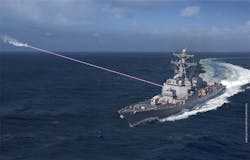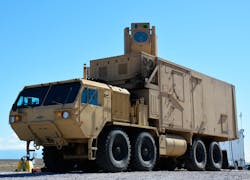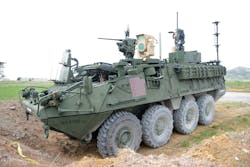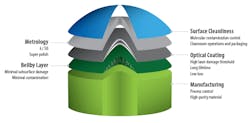Is a boom ahead for high-energy lasers on the battlefield?
A decade after U.S. Secretary of Defense Robert Gates told Congress that nobody in the Pentagon thought the Airborne Laser could be useful for missile defense, the three armed services are preparing to test 50 kW-class lasers on the battlefield. It’s not a change of politics—it’s a change of technology, from chemical lasers to electrically powered solid-state lasers, that makes high-energy laser weapons seem plausible. Current U.S. Undersecretary of Defense for Research and Engineering Mike Griffin talks of scaling solid-state powers to the megawatt class of the Airborne Laser and installing them in drones for missile defense.
The new technology offers vital new battlefield capabilities. “The country that is first to develop and field battlefield lasers will have a distinct military advantage,” says retired Lt. General Henry “Trey” Obering III. As head of the Missile Defense Agency (MDA) until three months before Gates spoke to Congress, he ran the Airborne Laser program. Now, an executive vice president at Booz Allen Hamilton, Obering wrote in March 2019, “the United States must develop lasers and other directed energy weapons sooner rather than later, and do so at a scale to put them into the hands of our warfighters in a meaningful way.” To keep progress from being limited by funding, he urges spending $2–3 billion a year.
That’s serious money, comparable in constant dollars to peak spending on laser weapons when the Reagan administration tried to develop space-based strategic defense to end the nuclear stalemate of the Cold War. The new generation of high-energy lasers are intended as tactical weapons for short-range defense against rockets, mortars, cruise missiles, attack boats, and emerging threats like drone swarms. The technology investment may be high, but military planners say a laser kill would cost only $30—cheap compared to interceptors like the Patriot missile.Navy laser programs
Navy field tests on the aging U.S.S. Ponce in the Persian Gulf made it look easy. The tests combined beams from half a dozen 5.5 kW industrial lasers to shoot down drones and detonate munitions on small boats, as millions have watched on YouTube. This year, the Navy will start testing an antisensor dazzler called ODIN (Optical Dazzling Interdictor, Navy) that can be added to essentially any Navy ship.
Now, the Navy is gearing up to test a multipurpose laser weapon system called HELIOS (High Energy Laser and Integrated Optical-dazzler with Surveillance). It combines an optical system useful for surveillance, a laser dazzler, and a 60 kW-class fiber laser weapon, resulting in the equivalent of a science-fiction ray gun that can be switched from “inspect” to “stun” to “kill.” Lockheed Martin is building two copies under a $150 million contract—one will go to the White Sands Missile Range for extensive testing of laser performance while the other will go on an Arleigh Burke class destroyer, a 500-ft. multimission warship in the active fleet, for tests of “Surface Navy Laser Weapon System 1” (see Fig. 1).
Installation will start in late 2021, followed by fleet testing through 2024. The goal is to see how well the laser and its sensing systems can be integrated with existing shipboard combat systems. “It’s a crawl, walk, run approach,” says Rear Admiral Ron Boxall. “Starting with the simple level, it’s closing the fire-control loop and moving from there” to more sophisticated battle operations. For now, he is concerned more about integrating the laser system with the existing Aegis weapon system than about power and beam quality. Integration with power systems will come later: the destroyer lacks the capacity to power the laser, but newer ships—even if smaller—should pack enough power to drive the laser.
The current testbeds are spectrally beam-combined fiber lasers that combine amplified outputs of several dozen fiber lasers at closely spaced wavelengths in the ytterbium band to generate a powerful beam of high optical quality. A planned second generation of lasers is expected to have higher power.
Army laser weapon programs
The Army wants lasers to zap mortars and drones. Figuring out how to squeeze the laser, power system, optics, pointing and tracking system, and operator into a battlefield vehicle is a challenge for engineers at the Army Space and Missile Defense Command at Redstone Arsenal (Huntsville, AL).
Their first testbed was a customized 16-ton military truck with eight-wheel drive called the High-Energy Laser Mobile Test Truck (HELMTT; see Fig. 2). In 2016, they installed a modified 10 kW commercial fiber laser, pointing and tracking system, 50 cm beam director, and chiller. Control initially was via a joystick and ruggedized laptop, but engineers found that young soldiers needed only five minutes of training to learn how to operate the laser with a Microsoft Xbox controller. An onboard generator powered support equipment, but the laser needed external power. The Army recently installed a 50 kW fiber laser from Lockheed and upgraded other equipment for further tests.The Army also is building another mobile testbed as a “pre-prototype” meeting military size, weight, and power requirements to protect troops at fixed and semi-fixed bases. The High-Energy Laser Tactical Vehicle Demonstrator (HEL TVD) is based on a six-wheel-drive truck with 10-ton payload. A bit smaller than HELMTT, HEL TVD will carry a 100 kW-class fiber laser running on a generator and power-storage system, as well as other equipment. A team led by Dynetics (Huntsville, AL) will build the weapon system for $130 million—Lockheed will build the laser and the Rolls Royce LibertyWorks division (Indianapolis, IN) will design the integrated power and thermal management system. Target tests are to begin in fiscal 2022.
The Army also wants to arm its eight-wheeled Stryker armored fighting vehicles with tens of kilowatts of laser firepower. The Mobile Experimental High Energy Laser (MEHEL) started with
2 kW, then was upped to 5 kW, and in August 2018 was upgraded to 10 kW with a ruggedized commercial fiber laser fired through a 10 cm optical system (see Fig. 3).
“It’s the first combat vehicle in the Army that has a high-energy laser integrated fully on it as a self-contained weapon system,” Richard Yaw, chief of the high-energy laser division at the Space and Missile Defense Command Tech Center, said in March. “It’s also the first high-energy laser platform that has a soldier inside using the weapon to shoot down an unmanned aircraft system (UAS)—a drone.”
The next step for combat vehicles will be the MMHEL (Multi-Mission High Energy Laser), which will add beam-control and support systems to fully integrate a laser weapon system into a Stryker-based vehicle. Built around a 50 kW ruggedized fiber laser, its mission will be shooting down rockets, artillery, mortars, and drones. Tests are to start in 2021.Lasers for Air Force top guns
The Air Force faces even tougher size, weight, and power challenges in arming fighter pilots with lasers. In November 2017, the Air Force Research Laboratory (AFRL; Wright-Patterson AFB, OH) awarded Lockheed a $26.3 million contract to design and build the Self-protect High Energy Laser Demonstrator (SHiELD), which will emit tens of kilowatts. It will be pod-mounted on an F-15 fighter, with other equipment from Northrop Grumman and Boeing bringing its total cost to about $155 million.
Those specifications may be tough to meet. On January 11, 2019, AFRL announced it was planning a six-month study called CHELSEA, for Compact High Energy Laser Subsystem Engineering Assessment, to search for ways to scale laser power by 2024 “as a possible drop-in replacement for the SHiELD laser subsystem.”
All three armed service programs remain in research, development, and testing. A Space and Missile Defense Command spokesman explained that their job is to develop weapon concepts and assess their technical feasibility in the military environment. Then, higher-ups will decide if the technology is sound enough and the military need great enough to make it a “program of record” that would produce hardware in quantity for field deployment.
Tough optical requirements
Although the lasers get the headlines, the optics also must withstand extreme powers and harsh operating conditions. “These optics need to be pristine works of art, but troops in the field just wipe them with their sleeves,” says Brandon Light, manufacturing engineer at Optimax (Ontario, NY). Operating procedures must be developed that are reasonable for soldiers using the lasers in combat, but that won’t risk damage such as solvent degradation of optics. The company has made optics for pulsed lasers used for nuclear fusion and extreme-ultraviolet lithography, but coating manager Pete Kupinski says, “Directed-energy optics are hands-down the most challenging optics we make.” High peak powers can damage coatings, but intense continuous beams from weapon lasers can go deeper to ablate holes in the glass (see Fig. 4).
Optical reliability is high on the list of crucial questions to be answered in the coming round of laser tests. Industry wants long-term continuous operation to control costs. The military doesn’t expect a laser weapon to run 24/7, but they demand it be ready to fire whenever it’s needed to save lives. This takes both very careful measurements to know what to expect from the optics, and very careful fabrication to make sure that optics and coatings together can withstand high light intensities and do not accidentally zap friendly troops or equipment.
Higher powers, new lasers, and missile defense
In 2018, Griffin told Congress that current fiber lasers could be scaled to 300 kW to protect Air Force tankers. He also wants to install megawatt-class electrically powered lasers in high-altitude drones for boost-phase ballistic missile defense at altitudes above the range of the Airborne Laser. The MDA is conducting an ambitious power-scaling project that will culminate with tests of a Low Power Laser Demonstrator (LPLD) to test their ideas. Funded at $81 million in fiscal 2018, the program is budgeted for $224 million this fiscal year, with $116 million requested for 2020.
The agency will support the development of robust high-power pump diodes and three rival technologies to be tested for the optically pumped laser. First to start the scaling trials in 2020 will be a distributed gain laser that has evolved from the liquid-flow HELLADS laser developed by General Atomics (San Diego, CA). Scaling experiments on a fiber combining laser concept from the MIT Lincoln Laboratory (Lexington, MA) and on diode-pumped alkali lasers (DPALs) will be conducted in 2021. The down-select will follow, with an industrial prototype built in 2022 and the demonstrator to be finished by the end of 2024.
Looking to the future
Those are ambitious military schedules, although they may look leisurely from the civilian world. The basic laser physics of producing 50 kW fiber lasers may be fairly well understood, but scaling to higher powers inevitably will bring more complications. Complications are bound to occur when trying to reach megawatt-class powers.
Obering puts improvements in beam power and beam quality at the top of his list of investment priorities, putting the bill for that task at $2–3 billion. He lists reducing size, power, weight, and cost of lasers and improving the lethality of laser weapons as other major priorities, and says that more money needs to be invested in developing high-power lasers for use at high altitudes and in space.
Yet many more questions remain. How can lasers be integrated into battle management systems? How can a battlement system determine if a laser has “killed” a target that does not blow up? How can delicate optical systems be cleaned and repaired in a dusty, dirty war zone? How rugged will lasers and optics be on the battlefield or at sea? And finally, what if Donald Rumsfeld’s famous “unknown unknowns” are lurking with unpleasant surprises?
About the Author
Jeff Hecht
Contributing Editor
Jeff Hecht is a regular contributing editor to Laser Focus World and has been covering the laser industry for 35 years. A prolific book author, Jeff's published works include “Understanding Fiber Optics,” “Understanding Lasers,” “The Laser Guidebook,” and “Beam Weapons: The Next Arms Race.” He also has written books on the histories of lasers and fiber optics, including “City of Light: The Story of Fiber Optics,” and “Beam: The Race to Make the Laser.” Find out more at jeffhecht.com.




